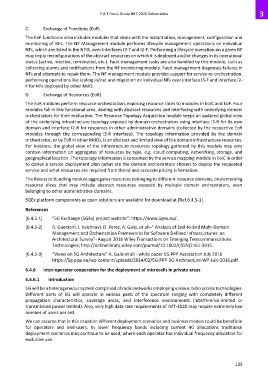Page 141 - ITU-T Focus Group IMT-2020 Deliverables
P. 141
ITU-T Focus Group IMT-2020 Deliverables 3
C. Exchange of Functions (EoF)
The EoF functional area includes modules that deals with the instantiation, management, configuration and
monitoring of NFs. The NF Management module performs lifecycle management operations on individual
NFs, which are listed in the NFIB, over interfaces I3-F and I2-F. Performing a lifecycle operation on a given NF
may imply reconfigurations of the abstract resources on which it is deployed and/or changes in its operational
status (active, inactive, terminated, etc.). Fault management tasks are also handled by this module, such as
collecting alarms and notifications from the NF monitoring module. Fault management diagnoses failures in
NFs and attempts to repair them. The NF management module provides support for service re-orchestration,
performing operations like scaling in/out and migration on individual NFs over interface I3-F and interface I2-
F for NFs deployed by other MdO.
D. Exchange of Resources (EoR)
The EoR modules perform resource orchestration, exposing resource slices to modules in EoIC and EoF. Four
modules fall in this functional area, dealing with abstract resources and interfacing with underlying domain
orchestrators for their realization. The Resource Topology Acquisition module keeps an updated global view
of the underlying infrastructure topology exposed by domain orchestrators using interface I3-R for its own
domain and interface I2-R for resources in other administrative domains (collected by the respective EoR
modules through the corresponding I3-R interface). The topology information provided by the domain
orchestrator, or by EoR in other MdOs, is an abstract and limited view of the domain infrastructure resources.
For instance, the global view of the infrastructure resources topology gathered by this module may only
contain information on aggregates of resources by type, e.g. cloud computing, networking, storage, and
geographical location. The topology information is consumed by the service mapping module in EoIC in order
to derive a service deployment plan (what are the domain orchestrators chosen to deploy the requested
service and what resources are required from them) and accurate pricing information.
The Resource Bundling module aggregates resources belonging to different resource domains, implementing
resource slices that may include abstract resources exposed by multiple domain orchestrators, even
belonging to other administrative domains.
5GEx platform components as open solutions are available for download at [Ref.6.4.5-1].
References
[6.4.5-1] “5G Exchange (5GEx) project website”: https://www.5gex.eu/.
[6.4.5-2] R. Guerzoni, I. Vaishnavi, D. Perez, A. Galis, et all–“ Analysis of End-to-End Multi-Domain
Management and Orchestration Frameworks for Software Defined Infrastructures: an
Architectural Survey”- August 2016 Wiley Transactions on Emerging Telecommunications
Technologies; http://onlinelibrary.wiley.com/journal/10.1002/(ISSN)2161-3915.
[6.4.5-3] “Views on 5G Architecture” A. Galis et all - white paper 5G PPP Association July 2016
https://5g-ppp.eu/wp-content/uploads/2014/02/5G-PPP-5G-Architecture-WP-July-2016.pdf.
6.4.6 Inter-operator cooperation for the deployment of microcells in private areas
6.4.6.1 Introduction
5G will be a heterogeneous system comprised of radio networks employing various radio access technologies.
Different parts of 5G will operate in various parts of the spectrum ranging with completely different
propagation characteristics, coverage areas, and interference environments (interference-limited or
transmission power limited). Also, very high data rate requirements of IMT-2020 may require extremely low
number of users per cell.
We can assume that in this situation different deployment scenarios and business models could be beneficial
for operators and end-users. In lower frequency bands including current 4G allocations traditional
deployment scenarios may continue to be used, where each operator has individual frequency allocation for
exclusive use.
135

